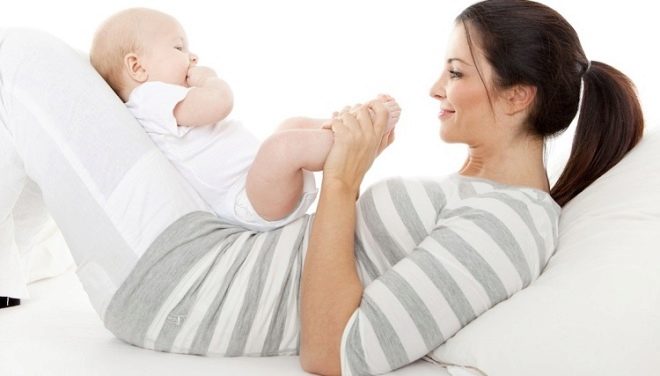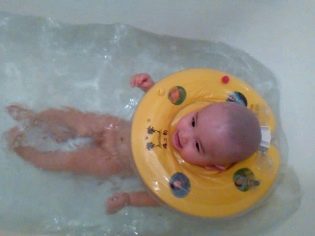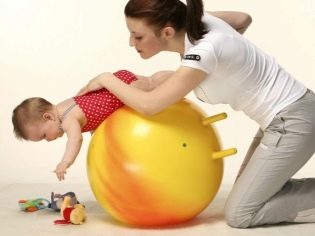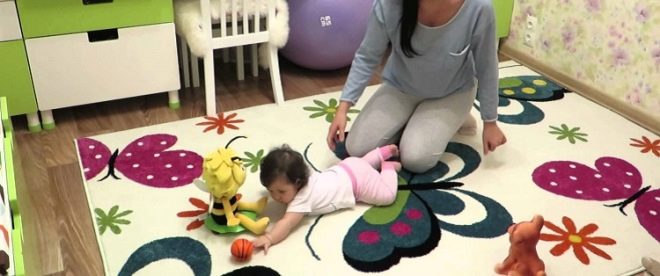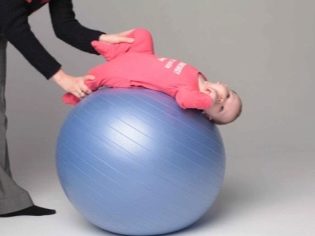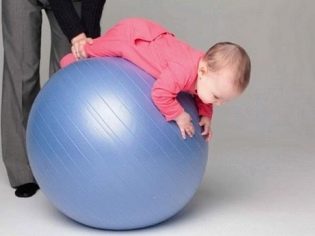When does a child start to sit and what exercises contribute to this?
Mom and other relatives perceive each new baby's skill with delight. Pride is overwhelming, I want to immediately share with everyone the surprisingly important news - the baby is sitting on the pope. But the same strong emotions, only with a negative sign, are experienced by women when their babies refuse to sit on time for this. In this article we will find out when a child should learn to sit and how to help him learn this skill without causing harm.
Terms and norms
The ability to sit is quite difficult and requires compliance with a number of specific conditions. First, the back muscles should be ready for this, and second, the spine and hip joints of the infant should be sufficiently mature.
According to the established pediatric practice, it is believed that the average child should sit down with support at 6 months, and already at 7 months the child begins to sit without support, himself. To sit from a prone position without assistance, the baby, according to the standards adopted by the doctors, should be 8 months old.
However, these norms are therefore called the average, because they do not take into account the individual characteristics of the individual child. Therefore, from the point of view of practice, it is wiser to assume that the baby begins to sit between six months and 8-9 months. On how well prepared the muscles of his back, abdomen and arms and ultimately depends on the period of mastering a new skill. Having learned to sit, the baby will receive a significant expansion of its capabilities in the knowledge of the world. In addition, this position is considered to be a transition to the ability to stand, and then move on to both of them.
More active children may attempt to sit down before half a year, and less active ones may well be slow to the last. This is also not unusual or pathological. Although much depends on how a pediatrician observing a child belongs to the average norms. A specialist who is not too troublesome can dryly state the child’s lag behind the physical developmental norms, which will upset the parents greatly.
Good specialists in the field of children's health emphasize the individuality of the timing of sitting. The skill develops according to a certain plan, and attentive parents will surely notice signs of a child’s quick mastery of a new skill if they know the characteristics of the stages of formation.
Stages of skill development
To prepare for the upcoming sitting kids begin in advance. As all muscle groups and especially the muscle tissue of the back strengthen, the baby begins to roll, spin, try to take a vertical position on the bottom, leaning on the handles. In a physically developed healthy baby, the first such attempts can be observed as early as 4.5 months. The child, of course, falls, but he persistently tries again to rise on his arm and sit down.
The first stage is called the stage of short-term sitting. The kid, even if he manages to sit down, cannot hold his body weight in such a position for a long time and collapses back on its side. It is at this stage that injuries to the face and head are not excluded, because if the baby falls, it may well hit the head against the side walls of the crib.
Already at the preparatory stage It is important to ensure your baby is safely falling. - put on four sides of it small soft pillows.Attempts to sit down must occur in your presence, because the likelihood of injury or mechanical asphyxiation will continue in the presence of pillows.
Short-term stage is usually mastered in a couple of months. Then the baby begins to sit down and briefly hold on to its weight, although with the balance it is still quite problematic. The second stage of skill acquisition begins - a seat with support.
You can help your child maintain balance by holding him; you can gradually plant your baby with his own pen. So, somewhat kosoboko, children usually sit for a short time - this is inconvenient and impractical, because both hands are necessary for him to play and tactile knowledge of the world around.
It is the inability to fully possess two hands that stimulates the child to move to a new stage. Within a month, the babies can sit without support, while the entire burden rests on the spine. By 8 months, many children can already spend a lot of time sitting, doing an interesting toy. It is at this stage that you can begin to move to crawling, if the crumb did not make any independent attempts to move on his stomach or four limbs.
At the final stage (approximately 9-10 months), the child can sit on his own from a prone position. For some, it is easy, others obviously suffer, puff and try to do it quickly, but it does not work. The way in which the baby sits does not matter much. Some do it with support on their hands, others - through an intermediate posture on all fours, others are looking for, to grab hold of, to pull themselves up on their hands and sit down. The main thing is the result.
Why is the baby not sitting?
With such a question, parents often turn to pediatricians. But to answer it is definitely quite difficult, because the reasons can be quite a lot. So, if the baby was born before the obstetric period, the development of his bone and muscular systems requires more time: premature babies begin to sit down later because of the lack of readiness to learn a new skill.
An overweight baby, although it delights relatives with puffy cheeks and legs, will sit down much later than children with normal weight. If the baby has problems with hip joints, which were identified even when the baby was a newborn, you do not need to sit down.
Slower children learn new skills that do not have the appropriate conditions - the baby is tightly swaddled after six months, they do little to do, do not do gymnastics, massage, do not leave them for a long time with their hands and toys open.
Equally important is the temperament of the child. There are calm and measured phlegmatic and melancholic, who simply do not see an incentive to take a different position, they prefer to eat tight and sleep a little longer. And there are moving and inquisitive choleric and sanguine who are difficult to keep from everything new, and therefore already by default interesting.
If the lack of skill is the only complaint of the parents, there is nothing to worry about, just the time for this baby has not come yet. However, if the lack of skill is accompanied by other symptoms - abundant frequent regurgitation, pale skin, lack of emotional reactions to the child to the mother and father, lack of ability to roll over and confidently hold the head, then you should definitely consult a doctor.
A history of pathologies such as ischemia, cerebral hemorrhage after birth, cerebral hypoxia in the absence of attempts to sit down after 7-8 months is also a good reason to visit a neurologist.
Boys and girls - features and skills
In forums on the Internet, young mothers actively discuss the abilities and nuances of the physical development of children of different sexes. For some reason, it is believed that girls develop faster. This is not true. The timing of attempts to sit down does not depend in any way on the sex of a child.
Another common misconception says that the boys can sit down earlier, but even the independent attempts of girls to sit down to half a year should be resolutely stopped. This is explained by the fact that the reproductive system of the girl is designed in such a way that early verticalization can disrupt the anatomical location of the uterus in the pelvis.
In fact, children of both sexes are not recommended early sitting down, this also applies to boys too. And not because something irreversible and terrible can happen to the reproductive system, but because the irreversible or intractable can happen to the spine and hip joints. As for girls, early forced verticalization can lead to pelvic bone injuries, which in the future can really lead to problems with reproduction.
Often the question arises whether to stop the attempts of the girls to sit down before six months. If the baby is well developed, as evidenced by her independent and spontaneous attempts to sit down, then you should not interfere with her daughter. Exactly the same tactics should be followed with small boys. But if the child himself does not yet demonstrate any desire to sit, then it will be a big mistake to seat the child, to lay pillows and ottomans.
Believing that in this way they help the child, the parents harm the baby. Excessive load on the spine ahead of the time set by nature itself for a particular child can lead to vertebral injuries, impaired hardening of the joints, which in the future can not only spoil the child’s posture and gait, but also cause disability.
Exercises and gymnastics
Gymnastics should not be only charging "to sit down." This is a complex effect on the body of the baby, contributing not to the development of the actual skill, but to the development of the muscles of the crumbs. With developed muscles, both this and other skills will be easily comprehended by the child. Before gymnastics be sure to spend a light tonic massage. This will make the complex exercises more effective. Always do the exercises in the form of a fun game, otherwise the child will quickly become bored with the manipulations of the mother with his body, and he will begin to protest against such leisure.
As we already know, for sitting you need to have developed muscles of the back, arms, abdomen. That is why it is necessary to include active and passive exercises to stimulate these particular muscle groups in daily exercises. Here are some interesting and useful exercises.
"Fish"
This exercise is performed in water, for example, in a large bath during evening bathing. For him, you will need a special orthopedic inflatable circle on the baby’s neck. It reliably fixes the cervical vertebrae and does not allow the crumbs to go to the bottom.
Wearing a circle, put the child in the water on the belly and behind the leg roll back and forth in the water. Then leave him in that position, wait a bit - the baby should turn back. Turns in the water are much easier and easier.
After swimming on your back, take the baby by one handle and stimulate his coup back on your stomach. The more he takes turns during a swimming session, the better. Exercise can be performed from a very early age - from 1 month.
"Swing"
Starting position - lying on your back. The surface must be tough. This exercise is not performed on a soft bed, which cannot provide anatomically correct support for the spine.
Stretch your index fingers for the child and let him grasp them. Slowly lift the crumbs into a half-sitting position. No need to plant a child, it is enough to raise the upper body by 45 degrees. Then slowly lower the baby back.
The secret of this exercise is that you need to do everything slowly. While you are doing it, the muscles in your arms and back tighten as much as possible. Exercise is recommended from 4-5 months.
"Pilot"
With your right hand, clasp the child lying on the belly around the body and place your palm under the rib cage, and with your left support it under the legs.
Lift the child above the surface of the massage table - while the baby reflexively strains the back, buttocks and raises the head, stretching the arms to the sides. Hold it for about 30-40 seconds in this position and gently lower it on the tummy back to the surface. Exercise recommended from 4 months.
"Caterpillar"
This exercise is done in a pose lying on his stomach. Before the baby you need to put a toy, but so that he could not take it. Easily pushing your hands on the baby's feet, stimulate his inertial repulsion and creeping forward. It will look like the characteristic caterpillar body movements during the movement. Perform until the baby does not “crawl” to the goal and does not grab onto the toy.
"On the ball"
Effectively strengthen the muscles of the back and abdomen fitball exercises. Put the child back first, supporting the legs on the ball, and easily swing it back and forth, in the right and left sides, and then in a circle.
Turn the baby on the stomach and do it all over again. This will not only strengthen the muscles, but also develop the vestibular apparatus, which will definitely come in handy at the stage of mastering the seat, in which you need to be able to balance.
Opinion of Dr. Komarovsky
The famous pediatrician Yevgeny Komarovsky claims that a healthy baby does not need the help of parents, he will sit down himself and do it when he is ready. Moreover, there should be no help from the category of “bear services”. These, undoubtedly, include such an achievement of mankind as jumpers.
Many parents are proud of themselves, having bought such a gift to the child. They hang the baby in the jumpers and are sure that he hangs in them and trains in an emergency mode.
In fact, according to Komarovsky, in jumpers, the child is under stress, but the baby’s spine experiences even more stress. If the baby manages to push off the legs from the floor, the situation is further complicated by the likelihood of a compression fracture and vertebral microtraumas.
The most useful exercise Komarovsky calls laying on the belly. The doctor recommends training other muscles purposefully only after careful observation of how the child is sitting (or trying to sit). If the back is rounded at the same time, one can speak of weak long back muscles, if it falls on its side, one should pay attention to the abdominal muscles and lateral groups of muscles.
Sit down the child forcibly - parental crime, says Yevgeny Olegovich. It is forbidden to plant a child who cannot sit in the stroller with its seat belts or in the hospitable space of soft pillows.
When the child starts to sit down, you need to avoid pathological postures. Evgeny Komarovsky refers to them as a seat with legs bent at the knees, turned back. If you look at the child from above, his posture will look like a Latin "W". In this position, incredible loads fall on the hip joints and knees, which can cause severe pathologies and leg deformities. In this case, the desire and desire of the mother to help the baby will be quite appropriate - teach the child to sit properly, and this will be the best help. Much more useful than mom's attempts to teach a child who just turned six months old to just sit.
Dr. Komarovsky will tell you about the age at which a child should learn to sit, walk, and so on in the next video.




